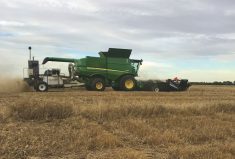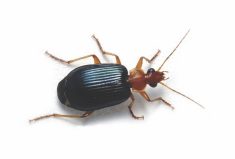When it comes to biopesticides, most researchers say that despite today’s limited selection of bio-based fungicides, insecticides and herbicides, the technology’s potential is extraordinary.
Public and private scientists are especially excited by an “all natural” basis for developing new active ingredients. Since most of the elements for these biopesticides come from natural sources, they point out, resistance is all but ruled out, and concerns about residue limits are also reduced.
That’s much of the story behind Phomo macrostoma, a bioherbicidal fungus developed by a research team at Agriculture and Agri-Food Canada (AAFC) in Saskatoon. Last April, AAFC entered into a partnership with Premier Tech to further develop, register and commercialize Phoma macrostoma for a wider farm market.
Read Also

Producers aren’t panicking over tariffs and trade threats
The influence of tariff and trade uncertainity on farm business decisions.
Currently, Phoma’s only registered crop is turf, for broadleaf weed control, including dandelion.
Work on this interaction dates back to 2001, when the effects of the naturally occurring fungus were first seen in dandelion. Subsequent work showed a similar impact on other broadleaf weeds, including Canada thistle and chickweed. The federal government, Western Grains Research Foundation and others have provided funding for the research over a 10-year period, and the studies continue today.
How it works
Phoma interferes with chlorophyll production in susceptible plants, causing bleaching (chlorosis) in the plant tissues, and subsequent death. Among the tested species, dandelion and wild mustard saw the greatest level of control. In initial research, dandelion exhibited 86 per cent photo bleaching and 92 per cent mortality. Wild mustard, a considerable scourge in Western Canada, displayed 61 percent photo bleaching and 61 percent mortality.
That research was published in June 2011 by a team of researchers that included Dr. Karen Bailey with AAFC-Saskatoon. In all, Phoma macrostoma 94-44B, as it’s known, was evaluated on 94 plant species, along with target and non-target weeds. Generally, the fungus was pathogenic to dicotyledon plants (legumes and most vegetable crops) but not so with monocots (corn and cereals). Dandelion and wild mustard were two of the weed species tested using Phoma, but there were a total of 29 species and 14 plant families that were assessed to start. Pigweed, common ragweed, perennial sowthistle and lamb’s quarters were among the others evaluated, yet all saw lower levels of bleaching and mortality (see Table 1 below).

Five years later, researchers learned that Phoma produces a biosynthetic metabolite called macrocidin as its active ingredient. Macrocidins inhibit an enzyme called phtyoene desaturase, thereby interfering with photosynthesis and creating the bleaching effect — and then death — in the leaves of susceptible plants.
Dr. Russell Hynes, who works in microbiology, biopesticide research and development with AAFC’s Saskatoon Research and Development Centre, is the lead on Phoma macrostoma’s work on weed susceptibility. He was also one of the authors for subsequent study results published in 2015 and 2016, helping define macrocidin’s effects. He notes that Phoma is being developed for use in organic and conventional farming practices, and that work continues on other crops, without any preference for east or west cropping systems.
“Several farmers have told me that no herbicide is perfect, and most farmers I speak with want to reduce synthetic chemical inputs to their land,” says Hynes, who is also adjunct professor in food and bioproducts sciences at the University of Saskatchewan. “However, I know that every farmer’s bottom line is cash return on the product they use: Phoma will not be the product for some farmers, and that’s a fact.”
In 2015 and 2016, Phoma was field-tested by an organic grower from Radville, Sask., who determined the efficacy on his farm to be roughly 80 per cent control on Canada thistle and 90 per cent on wild mustard. In the 2011 study, bleaching on Canada thistle was 40 per cent with a 74 per cent mortality rate, (the application rate was four times the normal standard). Dandelion meanwhile, has become one of the harder-to-control weed species in winter wheat production in Eastern Canada.
“We’ve tested Phoma on corn (not susceptible), potatoes (not susceptible) and soybean — which appears to be not susceptible, but testing in Eastern Canada is needed,” says Hynes.
A long way to go
For all of the promise, there is still the long road to registration and commercialization of the product, beyond its current usage in turf. That’s where Premier Tech has stepped in to take things to the next level. Marc Béland, the company’s market development director, acknowledges several factors influence Phoma’s evolution. First is the production stage, to bring it to a broader scale for use in agriculture.
“But there’s also the whole scale-up of production and formulation to bring a product to market that’s registered for agricultural use,” says Béland, who’s had numerous calls from growers concerning its capabilities and availability. “Where we stand right now is that Phoma has a huge potential to bring new tools to agriculture.”
Yet the challenges of registering and industrial-scale production are hard to overcome. Béland notes Premier Tech is setting its sights on 2020 for having a product registered for use on a broader cropping scale.
The good news is that Premier Tech is targeting a launch across Canada, as opposed to one half of the country versus the other. Béland concedes that given its Western Canada base for development, the logical assumption would be that producers there could expect to see it first. But that’s not the case.
Work will continue to determine its use in more eastern-oriented cropping systems, including corn and soybeans. Yet with crops such as alfalfa, more caution towards sensitivities will be needed.
“For agriculture, it would be best for both sides of the country,” says Béland, agreeing that there may be more of an immediate fit for Western Canada. “A good proportion of the interest I’ve been getting is from organic producers, who are pretty limited in what they can use to control weeds, so they see a lot of potential with Phoma.
Resistance is difficult
One of the advantages for bioproducts such as Phoma is their ability to fend off resistance. Two years ago, a panel discussion titled, “A new paradigm for biotech in ag” was held in St. Louis, Missouri. Although the focus was on bio-based biotech research and development, the discussion included references to the similarities between biotech applications based on naturally occurring agents and those within the biopesticide sector. At the time, biopesticides were worth between $2 billion and $3 billion, compared to the chemical pesticide market’s $55 billion to $60 billion value. But the biopesticide growth rate was 15 to 16 per cent in 2015, while the chemical sector’s was in the single-digit realm.
The limited potential for the development of biopesticides may be another important factor in their development. Microbes, enzymes or other biochemical structures often affect more than one point or pathway in a plant. They are also biodegradable, and this “natural” ability means they don’t exist long enough for resistance to develop.
“Phoma affects multiple points in the metabolic machinery of the targeted weed species,” says Hynes. “I’d suggest that resistance will take a very long time to develop. Phoma or macrocidin residue a year later is not detectable, so Phoma-sensitive crops can be seeded.”
Another advantage of using biopesticides is that they can actually lengthen the life of currently existing herbicides, fungicides, insecticides, as well as biotech applications such as Bt corn hybrids or glyphosate-resistant technologies.
“Based on my research in the soil types I’ve tested, broadleaved crop response to Phoma in different soil or climatic zones may vary somewhat,” states Hynes. “I’m currently examining dose application and application timing, including crop seeding and the weed cotyledon and first true leaves stages.”
This article was originally published in the September 2017 issue of the Corn Guide.
















